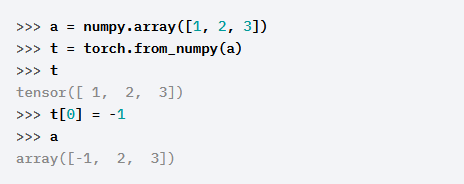Python zip() 函数

参考链接:Python zip() 函数
Python dict() 函数
 pandas.get_dummies 的用法
pandas.get_dummies 的用法
get_dummies 是利用pandas实现one hot encode的方式

CSR-matrix稀疏矩阵(附demo)

Python enumerate() 函数


python coo_matrix的理解和用法

NumPy和SciPy - .todense()和.toarray()之间的区别

 one-hot encoding和常规label的转化
one-hot encoding和常规label的转化
 coo_matrix
coo_matrix


Scipy 稀疏矩阵

mtx = sparse.coo_matrix((3, 4), dtype=np.int8)
print(mtx.todense())
>>> [[0 0 0 0]
[0 0 0 0]
[0 0 0 0]]
row = np.array([0, 3, 1, 0])
col = np.array([0, 3, 1, 2])
data = np.array([4, 5, 7, 9])
mtx = sparse.coo_matrix((data, (row, col)), shape=(4, 4))
print(mtx)
>>> (0, 0) 4
(3, 3) 5
(1, 1) 7
(0, 2) 9
print(mtx.todense())
>>> [[4 0 9 0]
[0 7 0 0]
[0 0 0 0]
[0 0 0 5]]
row = np.array([0, 0, 1, 3, 1, 0, 0])
col = np.array([0, 2, 1, 3, 1, 0, 0])
data = np.array([1, 1, 1, 1, 1, 1, 1])
mtx = sparse.coo_matrix((data, (row, col)), shape=(4, 4))
print(mtx.todense())
>>> [[3 0 1 0]
[0 2 0 0]
[0 0 0 0]
[0 0 0 1]]
#不支持索引
print(mtx[2, 3])
>>> Traceback (most recent call last):
File "/Users/shenyi/Documents/Untitled.py", line 21, in <module>
print(mtx[2, 3])
TypeError: 'coo_matrix' object is not subscriptable
eye(m[, n, k, dtype, format]):对角线为1的稀疏矩阵
identity(n[, dtype, format]):单位矩阵
diags(diagonals[, offsets, shape, format, dtype]):构造对角矩阵(含偏移量)

torch.from_numpy(ndarray) 功能及举例


pytorch中torch.manual_seed()的理解



每次运行的结果是相同的
import argparse模块总结
 关于python中.item()的用法
关于python中.item()的用法

 torch.optim.Adam优化器参数学习
torch.optim.Adam优化器参数学习
 model.train()
model.train()
在使用pytorch构建神经网络的时候,训练过程中会在程序上方添加一句model.train(),作用是启用batch normalization和drop out。
 参考链接:pytorch model.train()
参考链接:pytorch model.train()